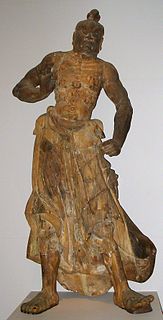The Rensho(連署, "co-signatory") was the assistant to the shikken (regent) of the Kamakura shogunate in Japan. [1]
The shikken was a titular post held by a member of Hōjō clan, officially a regent of the shogunate, from 1199 to 1333, or during the Kamakura period, therefore it was head of the bakufu (shogunate). It was part of the era referred to as Regent Rule.
A regent is a person appointed to govern a state because the monarch is a minor, is absent or is incapacitated. The rule of a regent or regents is called a regency. A regent or regency council may be formed ad hoc or in accordance with a constitutional rule. "Regent" is sometimes a formal title. If the regent is holding his position due to his position in the line of succession, the compound term prince regent is often used; if the regent of a minor is his mother, she is often referred to as "queen regent".

The Kamakura shogunate was a Japanese feudal military government of imperial-aristocratic rule that ruled from 1185 to 1333. The heads of the government were the shōguns. The first three were members of the Minamoto clan. The next two were members of the Fujiwara clan. The last six were minor Imperial princes.
Contents
The rensho placed his signature next to that of the shikken on official orders. [1] In 1224 the third shikken Hōjō Yasutoki appointed Hōjō Tokifusa as the first rensho. [1] From then on, the rensho was chosen from influential members of the Hōjō clan, [1] but not from the main line of the clan ( tokusō ), with the one exception of Tokimune, who temporarily occupied the position from 1264 to 1268.
Hōjō Yasutoki was the third shikken (regent) of the Kamakura shogunate in Japan. He strengthened the political system of the Hōjō regency.
Hōjō Tokifusa was a member of Japan's Hōjō clan of nobles and courtiers; the brother of Hōjō Yoshitoki, shogunal regent, Tokifusa was appointed to the Kyoto-based government post of Rokuhara Tandai upon its creation in 1221, following the Jōkyū War. He served alongside Hōjō Yasutoki.

The Hōjō clan in the history of Japan was a family who controlled the hereditary title of shikken (regent) of the Kamakura shogunate between 1203 and 1333. Despite the title, in practice the family wielded actual governmental power during this period compared to both the Kamakura shōguns, or the Imperial Court in Kyoto, whose authority was largely symbolic. The Hōjō are known for fostering Zen Buddhism and for leading the successful opposition to the Mongol invasions of Japan. Resentment at Hōjō rule eventually culminated in the overthrow of the clan and the establishment of the Ashikaga shogunate.


